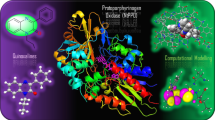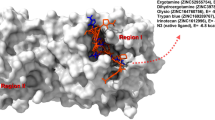Abstract
The UDP-N-acetylenolpyruvoylglucosamine reductase (MurB) catalyzes the final steps of the UDP-N-acetylmuramic acid (UDPMurNAc) formation in the peptidoglycan biosynthesis pathway. The absence of this pathway in mammals made it an attractive target for drug development in Mycobacterium tuberculosis (MTB). In this study, the crystal structure of MurB from MTB (PDB Code: 5JZX and resolution of 2.2 Å) bound to FAD and K+ was obtained from Protein Data Bank (PDB). A total of 2157 compounds with the best binding conformations were obtained from the Zinc database through virtual screening. These compounds further screened for drug-likeness, pharmacokinetic properties, physicochemical properties (Lipinski rule of five), and molecular docking analysis to identified ligands with desirable therapeutic properties and good binding energies against MurB. The ligands with the best binding energies were subjected to molecular dynamic (MD) simulation and Molecular Mechanics Generalized-Born Surface Area (MM-GBSA) analyses. The results of the molecular docking and pharmacokinetics analyses revealed that seven compounds (7) had minimum binding energies ranged between – 11.80 and – 10.39 kcal/mol, lower than the binding energy of FAD ( – 10.06 kcal/mol). Four compounds with best binding energies (ZINC19837204 = – 11.80 kcal/mol, ZINC11839554 = – 11.47 kcal/mol, ZINC14976552 = – 10.77 kcal/mol) and ability to interact with the residues (ZINC12242812 = – 10.39 kcal/mol) of the substrate-binding site further selected for the molecular dynamic (MD) simulation analysis. The MD simulation showed that all the four ligands formed stable complexes in the binding site of the MurB after the 50 ns MD simulation. These compounds proposed to be novel inhibitors of MTB after in vivo and in vitro validation.








Similar content being viewed by others
References
Andres CJ, Bronson JJ, D'Andrea SV, Deshpande MS, Falk PJ, Grant-Young KA, Harte WE, Ho HT, Misco PF, Robertson JG, Stock D, Sun YX, Walsh AW (2000). 4- Thiazolidinones: novel inhibitors of the bacterial enzyme MurB. Bioorg Med Chem Lett. 10:715e7. https://doi.org/10.1016/s0960-894x(00)00073-1
Benson TE, Marquardt JL, Marquardt AC, Etzkorn FA, Walsh CT (1993) Overexpression, purification, and mechanistic study of UDP-N-acetylenolpyruvylglucosamine reductase. Biochemistry 32(8):2024–2030
Benson TE, Walsh CT, Hogle JM (1996) The structure of the substrate-free form of MurB, an essential enzyme for the synthesis of bacterial cell walls. Structure 4(1):47–54
Bouhss A, Dementin S, van Heijenoort J, Parquet C, Blanot D (1999) Formation of adenosine 5′-tetraphosphate from the acyl phosphate intermediate: a difference between the MurC and MurD synthetases of Escherichia coli. FEBS Lett 453(1–2):15–19
Bronson JJ, DenBleyker KL, Falk PJ, Mate RA, Ho HT, Pucci MJ, Snyder LB (2003) Discovery of the first antibacterial small molecule inhibitors of MurB. Bioorg Med Chem Lett 13(5):873–875
Case DA, Darden TA, Cheatham III TE, Simmerling CL, Wang J, Duke RE, Luo R, Crowley M, Walker RC, Zhang W, Merz KM, Wang B, Hayik S, Roitberg A, Seabra G, Kolossváry I, Wong KF, Paesani F, Vanicek J,Wu X, Brozell SR, Steinbrecher T, Gohlke H, Yang L, Tan C, Mongan J, Hornak V, Cui G, Mathews DH, Seetin MG, Sagui C, Babin V, Kollman PA(2008) AMBER 10. University of California, San Francisco
Cheng F, Li W, Zhou Y, Shen J, Wu Z, Liu G, Tang Y (2012) AdmetSAR: a comprehensive source and free tool for assessment of chemical ADMET properties
DeLano, W. L. (2002). The PyMOL user’s manual. DeLano Scientific, San Carlos, CA, 452.
Genheden S, Ryde U (2015) The MM/PBSA and MM/GBSA methods to estimate ligand-binding affinities. Expert Opin Drug Discov 10(5):449–461
Ghasemi F, Zomorodipour A, Karkhane AA, Khorramizadeh MR (2016) In silico designing of hyper-glycosylated analogs for the human coagulation factor IX. J Mol Graph Model 68:39–47
He JY, Li C, Wu G (2014) Discovery of potential drugs for human-infecting H7N9 virus containing R294K mutation. Drug Des Dev Ther 8:2377
Johansson MU, Zoete V, Michielin O, Guex N (2012) Defining and searching for structural motifs using DeepView/Swiss-PdbViewer. BMC Bioinf 13(1):173
Jothieswari D, Bhaskar Reddy K (2015) Molecular Docking studies of potential chemical inhibitors on multi-drug resistance genes in MTB. Int J Innov Drug Discovery 5(1):40–45
Kutterer KM, Davis JM, Singh G, Yang Y, Hu W, Severin A, Katz AH (2005) 4-Alkyl and 4, 4′-dialkyl 1, 2-bis (4-chlorophenyl) pyrazolidine-3, 5-dione derivatives as new inhibitors of bacterial cell wall biosynthesis. Bioorg Med Chem Lett 15(10):2527–2531
La Motta C, Sartini S, Mugnaini L, Simorini F, Taliani S, Salerno S, Cantore M (2007) Pyrido [1, 2-a] pyrimidine-4-one derivatives as a novel class of selective aldose reductase inhibitors exhibiting antioxidant activity. J Med Chem 50(20):4917–4927
Laskowski RA, Swindells MB (2011) LigPlot+: multiple ligand-protein interaction diagrams for drug discovery
Lipinski CA, Lombardo F, Dominy BW, Feeney PJ (2001) Experimental and computational approaches to estimate solubility and permeability in drug discovery and development settings1. Adv Drug Deliv Rev 46(1–3):3–26
Moraes GL, Gomes GC, De Sousa PRM, Alves CN, Govender T, Kruger HG, Lameira J (2015) Structural and functional features of enzymes of MTB peptidoglycan biosynthesis as targets for drug development. Tuberculosis 95(2):95–111
Morris GM, Goodsell DS, Halliday RS, Huey R, Hart WE, Belew RK, Olson AJ (1998) Automated docking using a Lamarckian genetic algorithm and an empirical binding free energy function. J Comput Chem 19(14):1639–1662
Murzin AG (1996) Structural classification of proteins: new superfamilies. Curr Opin Struct Biol 6(3):386–394
Pettersen EF, Goddard TD, Huang CC, Couch GS, Greenblatt DM, Meng EC, Ferrin TE (2004) UCSF Chimera-a visualization system for exploratory research and analysis. J Comput Chem 25(13):1605–1612
Veber DF, Johnson SR, Cheng HY, Smith BR, Ward KW, Kopple KD (2002) Molecular properties that influence the oral bioavailability of drug candidates. J Med Chem 45(12):2615–2623
Wallace AC, Laskowski RA, Thornton JM (1996) Derivation of 3D coordinate templates for searching structural databases: Application to Ser-His-Asp catalytic triads in the serine proteinases and lipases. Protein Sci 5(6):1001–1013
World Health Organization (2020). Global tuberculosis report 2020: executive summary
Yang Y, Severin A, Chopra R, Krishnamurthy G, Singh G, Hu W, Shlaes DM (2006) 3, 5-Dioxopyrazolidines, novel inhibitors of UDP-N-acetylenolpyruvylglucosamine reductase (MurB) with activity against Gram-positive bacteria. Antimicrob Agents Chemother 50(2):556–564
Acknowledgements
The corresponding author of this paper is very much grateful to Prof. Pawan Dhar (Jawaharlal Nehru University), Prof. B. Jayaram (Coordinator of the Supercomputing Facility for Bioinformatics & Computational Biology, IIT Delhi), Dr. Kalaiarasan P. (Jawaharlal Nehru University), and Mr. Shashank Shekhar (IIT Delhi) for their contribution and providing facilities.
Author information
Authors and Affiliations
Corresponding author
Additional information
Publisher's Note
Springer Nature remains neutral with regard to jurisdictional claims in published maps and institutional affiliations.
Rights and permissions
About this article
Cite this article
Isa, M.A., Mohammed, M.M. Molecular docking and dynamic simulation of UDP-N-acetylenolpyruvoylglucosamine reductase (MurB) obtained from Mycobacterium tuberculosis using in silico approach. Netw Model Anal Health Inform Bioinforma 10, 40 (2021). https://doi.org/10.1007/s13721-021-00317-3
Received:
Revised:
Accepted:
Published:
DOI: https://doi.org/10.1007/s13721-021-00317-3




